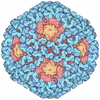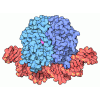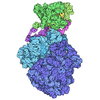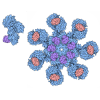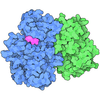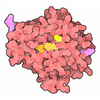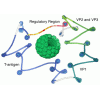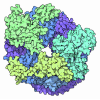+ Open data
Open data
- Basic information
Basic information
| Entry | Database: PDB / ID: 6xre | ||||||
|---|---|---|---|---|---|---|---|
| Title | Structure of the p53/RNA polymerase II assembly | ||||||
 Components Components |
| ||||||
 Keywords Keywords | TRANSCRIPTION / TRANSFERASE / Activator / tumor suppressor | ||||||
| Function / homology |  Function and homology information Function and homology informationmicrofibril binding / RNA Polymerase III Chain Elongation / RNA Polymerase III Transcription Termination / regulation of transcription by RNA polymerase I / RPAP3/R2TP/prefoldin-like complex / RNA Polymerase III Transcription Initiation From Type 1 Promoter / RNA Polymerase III Transcription Initiation From Type 2 Promoter / RNA Polymerase III Transcription Initiation From Type 3 Promoter / RNA Polymerase III Abortive And Retractive Initiation / Cytosolic sensors of pathogen-associated DNA ...microfibril binding / RNA Polymerase III Chain Elongation / RNA Polymerase III Transcription Termination / regulation of transcription by RNA polymerase I / RPAP3/R2TP/prefoldin-like complex / RNA Polymerase III Transcription Initiation From Type 1 Promoter / RNA Polymerase III Transcription Initiation From Type 2 Promoter / RNA Polymerase III Transcription Initiation From Type 3 Promoter / RNA Polymerase III Abortive And Retractive Initiation / Cytosolic sensors of pathogen-associated DNA / negative regulation of helicase activity / Loss of function of TP53 in cancer due to loss of tetramerization ability / Regulation of TP53 Expression / signal transduction by p53 class mediator / negative regulation of G1 to G0 transition / negative regulation of glucose catabolic process to lactate via pyruvate / Transcriptional activation of cell cycle inhibitor p21 / regulation of intrinsic apoptotic signaling pathway by p53 class mediator / negative regulation of pentose-phosphate shunt / ATP-dependent DNA/DNA annealing activity / Activation of NOXA and translocation to mitochondria / regulation of cell cycle G2/M phase transition / oligodendrocyte apoptotic process / negative regulation of miRNA processing / intrinsic apoptotic signaling pathway in response to hypoxia / regulation of fibroblast apoptotic process / positive regulation of thymocyte apoptotic process / oxidative stress-induced premature senescence / regulation of tissue remodeling / positive regulation of mitochondrial membrane permeability / mRNA transcription / bone marrow development / positive regulation of programmed necrotic cell death / circadian behavior / T cell proliferation involved in immune response / regulation of mitochondrial membrane permeability involved in apoptotic process / germ cell nucleus / RUNX3 regulates CDKN1A transcription / homolactic fermentation / TP53 Regulates Transcription of Death Receptors and Ligands / Activation of PUMA and translocation to mitochondria / TP53 regulates transcription of additional cell cycle genes whose exact role in the p53 pathway remain uncertain / Abortive elongation of HIV-1 transcript in the absence of Tat / FGFR2 alternative splicing / histone deacetylase regulator activity / RNA Polymerase I Transcription Termination / regulation of DNA damage response, signal transduction by p53 class mediator / MicroRNA (miRNA) biogenesis / negative regulation of glial cell proliferation / Regulation of TP53 Activity through Association with Co-factors / negative regulation of neuroblast proliferation / Viral Messenger RNA Synthesis / Signaling by FGFR2 IIIa TM / mitochondrial DNA repair / T cell lineage commitment / Formation of Senescence-Associated Heterochromatin Foci (SAHF) / LRR domain binding / ER overload response / thymocyte apoptotic process / B cell lineage commitment / TP53 Regulates Transcription of Caspase Activators and Caspases / entrainment of circadian clock by photoperiod / cardiac septum morphogenesis / positive regulation of nuclear-transcribed mRNA poly(A) tail shortening / negative regulation of mitophagy / RNA Pol II CTD phosphorylation and interaction with CE during HIV infection / RNA Pol II CTD phosphorylation and interaction with CE / HIV Transcription Initiation / RNA Polymerase II HIV Promoter Escape / Transcription of the HIV genome / RNA Polymerase II Promoter Escape / RNA Polymerase II Transcription Pre-Initiation And Promoter Opening / RNA Polymerase II Transcription Initiation / RNA Polymerase II Transcription Initiation And Promoter Clearance / Formation of the Early Elongation Complex / Formation of the HIV-1 Early Elongation Complex / mRNA Capping / negative regulation of DNA replication / Zygotic genome activation (ZGA) / positive regulation of release of cytochrome c from mitochondria / PI5P Regulates TP53 Acetylation / Association of TriC/CCT with target proteins during biosynthesis / mRNA Splicing - Minor Pathway / necroptotic process / TP53 Regulates Transcription of Genes Involved in Cytochrome C Release / PIWI-interacting RNA (piRNA) biogenesis / negative regulation of telomere maintenance via telomerase / TFIID-class transcription factor complex binding / SUMOylation of transcription factors / TP53 regulates transcription of several additional cell death genes whose specific roles in p53-dependent apoptosis remain uncertain / intrinsic apoptotic signaling pathway by p53 class mediator / maintenance of transcriptional fidelity during transcription elongation by RNA polymerase II / Processing of Capped Intron-Containing Pre-mRNA / rRNA transcription / negative regulation of reactive oxygen species metabolic process / RNA Polymerase I Transcription Initiation / nuclear-transcribed mRNA catabolic process / Transcriptional Regulation by VENTX / transcription by RNA polymerase III / positive regulation of translational initiation Similarity search - Function | ||||||
| Biological species |  Homo sapiens (human) Homo sapiens (human) | ||||||
| Method | ELECTRON MICROSCOPY / single particle reconstruction / cryo EM / Resolution: 4.6 Å | ||||||
 Authors Authors | Liou, S.-H. / Singh, S. / Singer, R.H. / Coleman, R.A. / Liu, W. | ||||||
| Funding support |  United States, 1items United States, 1items
| ||||||
 Citation Citation |  Journal: Commun Biol / Year: 2021 Journal: Commun Biol / Year: 2021Title: Structure of the p53/RNA polymerase II assembly. Authors: Shu-Hao Liou / Sameer K Singh / Robert H Singer / Robert A Coleman / Wei-Li Liu /  Abstract: The tumor suppressor p53 protein activates expression of a vast gene network in response to stress stimuli for cellular integrity. The molecular mechanism underlying how p53 targets RNA polymerase II ...The tumor suppressor p53 protein activates expression of a vast gene network in response to stress stimuli for cellular integrity. The molecular mechanism underlying how p53 targets RNA polymerase II (Pol II) to regulate transcription remains unclear. To elucidate the p53/Pol II interaction, we have determined a 4.6 Å resolution structure of the human p53/Pol II assembly via single particle cryo-electron microscopy. Our structure reveals that p53's DNA binding domain targets the upstream DNA binding site within Pol II. This association introduces conformational changes of the Pol II clamp into a further-closed state. A cavity was identified between p53 and Pol II that could possibly host DNA. The transactivation domain of p53 binds the surface of Pol II's jaw that contacts downstream DNA. These findings suggest that p53's functional domains directly regulate DNA binding activity of Pol II to mediate transcription, thereby providing insights into p53-regulated gene expression. | ||||||
| History |
|
- Structure visualization
Structure visualization
| Movie |
 Movie viewer Movie viewer |
|---|---|
| Structure viewer | Molecule:  Molmil Molmil Jmol/JSmol Jmol/JSmol |
- Downloads & links
Downloads & links
- Download
Download
| PDBx/mmCIF format |  6xre.cif.gz 6xre.cif.gz | 1.4 MB | Display |  PDBx/mmCIF format PDBx/mmCIF format |
|---|---|---|---|---|
| PDB format |  pdb6xre.ent.gz pdb6xre.ent.gz | 1.2 MB | Display |  PDB format PDB format |
| PDBx/mmJSON format |  6xre.json.gz 6xre.json.gz | Tree view |  PDBx/mmJSON format PDBx/mmJSON format | |
| Others |  Other downloads Other downloads |
-Validation report
| Summary document |  6xre_validation.pdf.gz 6xre_validation.pdf.gz | 836.2 KB | Display |  wwPDB validaton report wwPDB validaton report |
|---|---|---|---|---|
| Full document |  6xre_full_validation.pdf.gz 6xre_full_validation.pdf.gz | 870 KB | Display | |
| Data in XML |  6xre_validation.xml.gz 6xre_validation.xml.gz | 111.4 KB | Display | |
| Data in CIF |  6xre_validation.cif.gz 6xre_validation.cif.gz | 171.5 KB | Display | |
| Arichive directory |  https://data.pdbj.org/pub/pdb/validation_reports/xr/6xre https://data.pdbj.org/pub/pdb/validation_reports/xr/6xre ftp://data.pdbj.org/pub/pdb/validation_reports/xr/6xre ftp://data.pdbj.org/pub/pdb/validation_reports/xr/6xre | HTTPS FTP |
-Related structure data
| Related structure data |  22294MC M: map data used to model this data C: citing same article ( |
|---|---|
| Similar structure data |
- Links
Links
- Assembly
Assembly
| Deposited unit | 
|
|---|---|
| 1 |
|
- Components
Components
-DNA-directed RNA polymerase II subunit ... , 8 types, 8 molecules ABCDEGIK
| #1: Protein | Mass: 217420.047 Da / Num. of mol.: 1 / Source method: isolated from a natural source / Source: (natural)  Homo sapiens (human) / References: UniProt: P24928, DNA-directed RNA polymerase Homo sapiens (human) / References: UniProt: P24928, DNA-directed RNA polymerase |
|---|---|
| #2: Protein | Mass: 134071.453 Da / Num. of mol.: 1 / Source method: isolated from a natural source / Source: (natural)  Homo sapiens (human) / References: UniProt: P30876, DNA-directed RNA polymerase Homo sapiens (human) / References: UniProt: P30876, DNA-directed RNA polymerase |
| #3: Protein | Mass: 31478.148 Da / Num. of mol.: 1 / Source method: isolated from a natural source / Source: (natural)  Homo sapiens (human) / References: UniProt: P19387 Homo sapiens (human) / References: UniProt: P19387 |
| #4: Protein | Mass: 16331.255 Da / Num. of mol.: 1 / Source method: isolated from a natural source / Source: (natural)  Homo sapiens (human) / References: UniProt: O15514 Homo sapiens (human) / References: UniProt: O15514 |
| #5: Protein | Mass: 24584.223 Da / Num. of mol.: 1 / Source method: isolated from a natural source / Source: (natural)  Homo sapiens (human) / References: UniProt: P19388 Homo sapiens (human) / References: UniProt: P19388 |
| #7: Protein | Mass: 19314.283 Da / Num. of mol.: 1 / Source method: isolated from a natural source / Source: (natural)  Homo sapiens (human) / References: UniProt: P62487 Homo sapiens (human) / References: UniProt: P62487 |
| #9: Protein | Mass: 14541.221 Da / Num. of mol.: 1 / Source method: isolated from a natural source / Source: (natural)  Homo sapiens (human) / References: UniProt: P36954 Homo sapiens (human) / References: UniProt: P36954 |
| #11: Protein | Mass: 13310.284 Da / Num. of mol.: 1 / Source method: isolated from a natural source / Source: (natural)  Homo sapiens (human) / References: UniProt: P52435 Homo sapiens (human) / References: UniProt: P52435 |
-DNA-directed RNA polymerases I, II, and III subunit ... , 4 types, 4 molecules FHJL
| #6: Protein | Mass: 14491.026 Da / Num. of mol.: 1 / Source method: isolated from a natural source / Source: (natural)  Homo sapiens (human) / References: UniProt: P61218 Homo sapiens (human) / References: UniProt: P61218 |
|---|---|
| #8: Protein | Mass: 17162.273 Da / Num. of mol.: 1 / Source method: isolated from a natural source / Source: (natural)  Homo sapiens (human) / References: UniProt: P52434 Homo sapiens (human) / References: UniProt: P52434 |
| #10: Protein | Mass: 7655.123 Da / Num. of mol.: 1 / Source method: isolated from a natural source / Source: (natural)  Homo sapiens (human) / References: UniProt: P62875 Homo sapiens (human) / References: UniProt: P62875 |
| #12: Protein | Mass: 7018.244 Da / Num. of mol.: 1 / Source method: isolated from a natural source / Source: (natural)  Homo sapiens (human) / References: UniProt: P53803 Homo sapiens (human) / References: UniProt: P53803 |
-Protein , 1 types, 1 molecules M
| #13: Protein | Mass: 43711.176 Da / Num. of mol.: 1 Source method: isolated from a genetically manipulated source Source: (gene. exp.)  Homo sapiens (human) / Gene: TP53, P53 / Production host: Homo sapiens (human) / Gene: TP53, P53 / Production host:  unidentified baculovirus / References: UniProt: P04637 unidentified baculovirus / References: UniProt: P04637 |
|---|
-Non-polymers , 2 types, 9 molecules 


| #14: Chemical | ChemComp-MG / |
|---|---|
| #15: Chemical | ChemComp-ZN / |
-Details
| Has ligand of interest | N |
|---|
-Experimental details
-Experiment
| Experiment | Method: ELECTRON MICROSCOPY |
|---|---|
| EM experiment | Aggregation state: PARTICLE / 3D reconstruction method: single particle reconstruction |
- Sample preparation
Sample preparation
| Component |
| ||||||||||||||||||||||||
|---|---|---|---|---|---|---|---|---|---|---|---|---|---|---|---|---|---|---|---|---|---|---|---|---|---|
| Molecular weight | Experimental value: NO | ||||||||||||||||||||||||
| Source (natural) |
| ||||||||||||||||||||||||
| Source (recombinant) | Organism:  unidentified baculovirus unidentified baculovirus | ||||||||||||||||||||||||
| Buffer solution | pH: 7.9 | ||||||||||||||||||||||||
| Specimen | Embedding applied: NO / Shadowing applied: NO / Staining applied: NO / Vitrification applied: YES | ||||||||||||||||||||||||
| Specimen support | Details: unspecified | ||||||||||||||||||||||||
| Vitrification | Instrument: FEI VITROBOT MARK I / Cryogen name: ETHANE / Humidity: 100 % / Chamber temperature: 277 K Details: The assembled p53/Pol II co-complex was applied directly on the grid for 10 sec followed by 5.5 sec of blotting. The sample grid was then washed with 3.5% trehalose in 0.1 M KCl/HEM buffer ...Details: The assembled p53/Pol II co-complex was applied directly on the grid for 10 sec followed by 5.5 sec of blotting. The sample grid was then washed with 3.5% trehalose in 0.1 M KCl/HEM buffer (20 mM HEPES, 0.2 mM EDTA, 2 mM MgCl2 at pH 7.9) for 10 sec, blotted for 5.5 sec, and finally frozen in liquid ethane. |
- Electron microscopy imaging
Electron microscopy imaging
| Experimental equipment |  Model: Titan Krios / Image courtesy: FEI Company |
|---|---|
| Microscopy | Model: FEI TITAN KRIOS |
| Electron gun | Electron source:  FIELD EMISSION GUN / Accelerating voltage: 300 kV / Illumination mode: FLOOD BEAM FIELD EMISSION GUN / Accelerating voltage: 300 kV / Illumination mode: FLOOD BEAM |
| Electron lens | Mode: BRIGHT FIELD |
| Image recording | Average exposure time: 0.2 sec. / Electron dose: 1.16 e/Å2 / Detector mode: SUPER-RESOLUTION / Film or detector model: GATAN K2 SUMMIT (4k x 4k) |
- Processing
Processing
| CTF correction | Type: PHASE FLIPPING AND AMPLITUDE CORRECTION |
|---|---|
| Particle selection | Num. of particles selected: 776710 Details: 776,710 particles were automatically picked by SPHIRE-crYOLO along with PhosaurusNet network. |
| 3D reconstruction | Resolution: 4.6 Å / Resolution method: FSC 0.143 CUT-OFF / Num. of particles: 92522 / Symmetry type: POINT |
 Movie
Movie Controller
Controller






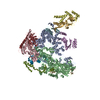



 PDBj
PDBj




